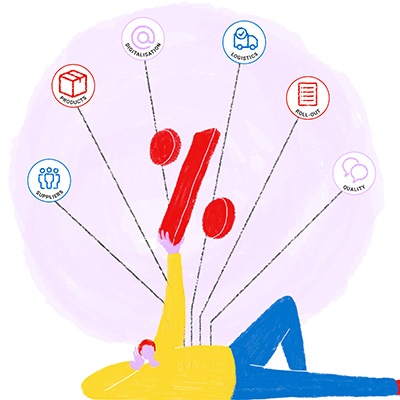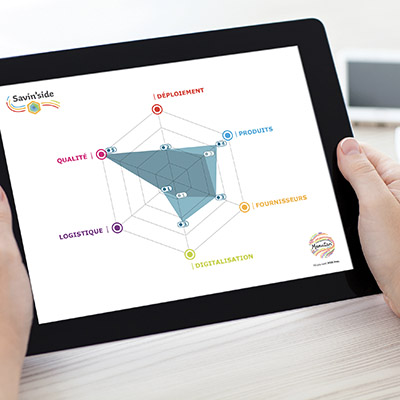Innovation is a strategic lever for companies wishing to remain competitive in a constantly evolving environment. Among the various tools at their disposal is collaborative innovation. This approach consists of pooling human and material resources from multiple stakeholders to implement innovative ideas, with a view to value creation. And it turns out to be a powerful development accelerator.
Innovation: Definition and typologies
The Oslo Manual, published by the OECD and Eurostat, defines innovation as: "A new or improved product or process (or combination thereof) that differs significantly from the unit’s previous products or processes and that has been made available to potential users (product) or brought into use by the unit (process)".
There are many ways of categorising innovations. Today, there is a consensus in the business world on four main types of innovation which complement the definition given above.
Incremental innovation
Incremental innovation consists of improving an existing product and/or service already on the market. In other words, it’s continuous improvement. While less sensational, this innovation remains highly effective.
Adjacent innovation
Adjacent innovation involves integrating an existing technology into a product and/or service. This is the perfect example of collaborative innovation. It creates a competitive advantage that differentiates the company in the marketplace.
Disruptive innovation
Disruptive innovation occurs when a company breaks prices, simplifies usage, or improves the comfort of an existing product and/or service in the market. This type of innovation destabilises the market and competition.
Radical innovation
Radical innovation designates the creation of a completely new product and/or service. While companies opting for this type of innovation often fail, those who succeed literally change users’ daily lives.
What is collaborative innovation?
By definition, collaborative innovation, as well as open innovation, involves bringing together diverse stakeholders to co-create innovative solutions that generate value for an organisation, its customers, or more globally, its ecosystem.
Collaborative innovation aims to gather various structures around common interests. We often find examples of collaborative innovation between a large company and its supplier, partner, or research organisation, within the same industrial sector or around competitiveness clusters. When collaborative innovation happens internally with the company’s teams, it is more often referred to as participatory innovation.
This innovation scheme allows companies to pool equipment and skills within a defined framework. It is thus a lever for cost reduction, thanks to economies of scale and expenditure breakdown, but also for reducing potential risks and speeding up the innovation process. Mutual trust is the precondition for implementing a successful collaborative innovation approach, as it involves sharing your resources and skills with your partner, opening the doors of your company to them and entering into a contractual agreement for the future. This collaboration is generally framed by a partnership contract, which provides clarifications regarding intellectual property and potential commercial outcomes.
Lastly, collaborative innovation is part of each company’s strategy. Without impetus from management, without a genuine culture of innovation, without a real willingness to broaden your vision, this type of project cannot emerge. "In research and innovation activities, a company might develop ten projects and ultimately have only one turn out profitable. An exclusively accounting-based vision cannot survive this observation. The innovation process must be part of a comprehensive strategic approach," as Daniel Lelaure, Technical Director at Metra, points out.
The main innovation methods
There are various methods to make innovative ideas concrete and stimulate creativity within companies. Each approach offers unique perspectives and design tools.
Design thinking
This innovation approach is user-centred. It relies on empathy and pushes members of a team to collaborate together to solve complex challenges. It involves putting yourself in the consumer’s or user’s shoes, defining the problem, designing an idea, prototyping, and testing. Each stage allows better understanding and response to users’ real needs by imagining the most effective solutions.
Blue ocean strategy
This strategy aims to move away from "red oceans" - saturated markets with fierce competition. The goal is to invest in "blue oceans" by creating new market spaces. This approach allows companies to stand out, stimulate new demand, and create growth opportunities.
Lean start-up
Inspired by Lean Management, this method enables developing innovation projects economically and thoughtfully. It involves promoting rapid experimentation, agility, and responsiveness. The aim is to test new ideas in the field, collect data, and adjust according to user feedback and expectations.
The procurement function at the heart of collaborative innovation
Procurement departments have a key role in facilitating innovation within their company. They are located at a strategic and decisional crossroads through supplier relationship management. They intervene both upstream of the project and during the development of innovative products and/or services.
Upstream phase
From the outset, the procurement function brings its expertise in defining needs, understanding the supplier market, constructing specifications, and contractualisation… This allows choosing the right partners while securing exchanges.
Development phase
When developing innovative products and/or services, procurement departments also play a crucial role. They will help define the strategy through their full cost vision and serve as interlocutors with suppliers involved in the approach. They will thus facilitate innovation while protecting their company’s interests.
Through collective intelligence and resource pooling, collaborative innovation is a source of operational and economic performance. It promotes the transformation of ideas into concrete, profitable, and value-added solutions. By relying on the right methods, trusted partners, open communication and by fostering a culture of collaborative innovation, this approach becomes a long-term strategic asset.









